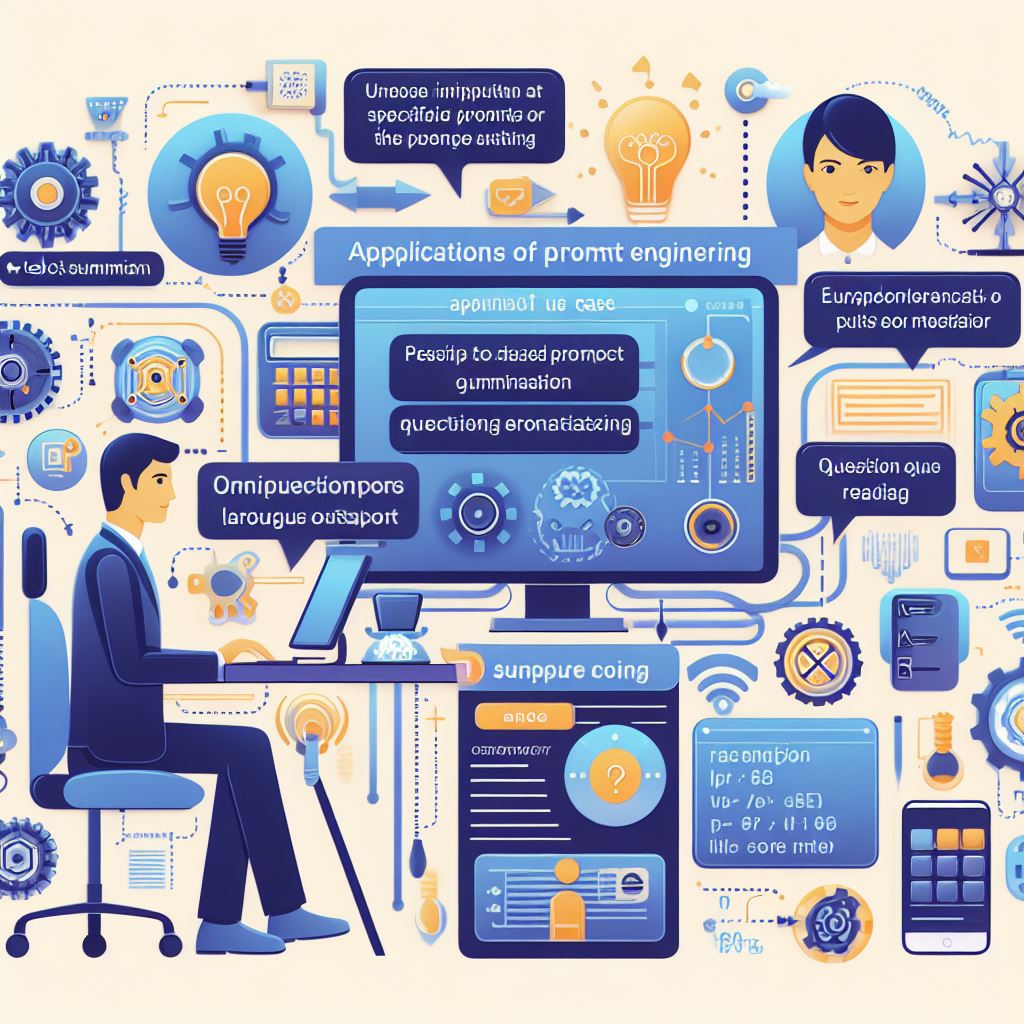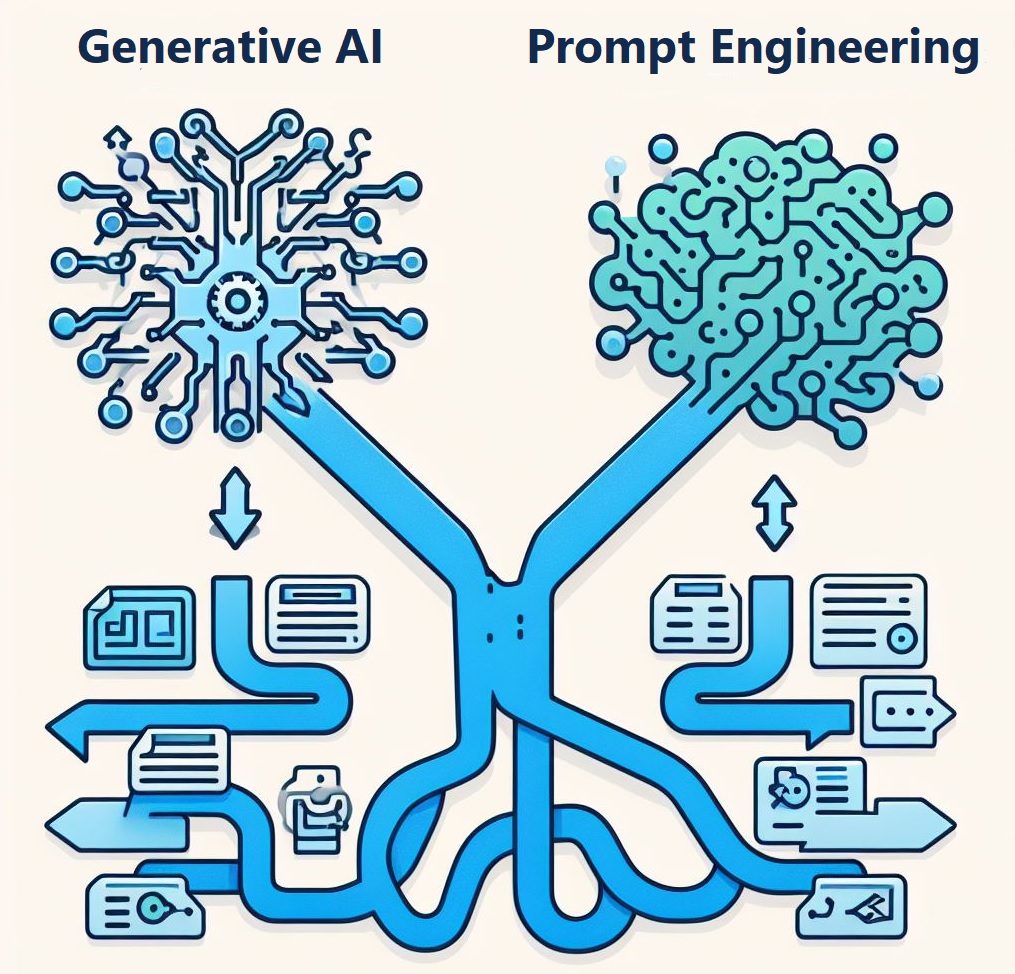Can Prompt Engineering be easily Demystified? Dive into the world of artificial intelligence as we explore generative AI and prompt engineering. Discover how these methodologies revolutionize content creation and output generation, shaping the future of technology and society.
Introduction to Generative AI and Prompt Engineering
In the rapidly evolving landscape of artificial intelligence (AI), two prominent methodologies have emerged: generative AI and prompt engineering. If Prompt Engineering to be Demystified we shall note that these approaches represent distinct paradigms in AI development, each with its own set of principles, techniques, and applications.
- Generative AI, at its core, revolves around the concept of machines autonomously creating content, whether it be text, images, music, or even entire simulations.
- On the other hand, prompt engineering focuses on providing specific instructions or prompts to AI systems to guide their output generation.
In this comprehensive exploration, we delve into the intricacies of generative AI and prompt engineering, shedding light on their respective functionalities, advantages, and limitations. Join us as we navigate the terrain of AI interaction and unravel the mysteries behind these groundbreaking methodologies.
1. Understanding Generative AI: Concepts and Applications
Generative AI represents a paradigm shift in artificial intelligence, empowering machines to exhibit creativity and produce content autonomously. At the heart of generative AI lies the idea of leveraging neural networks to generate new data samples that resemble those in the training dataset. This process involves learning the underlying patterns and structures within the data and using that knowledge to generate novel outputs.
1.1. Applications
One of the key applications of generative AI is in the field of natural language processing (NLP). Language models such as OpenAI’s GPT series and Google’s BERT have demonstrated remarkable capabilities in generating coherent and contextually relevant text. These models can be used for various tasks, including text generation, summarization, translation, and even dialogue generation.
Moreover, generative AI has found applications beyond NLP, extending into domains such as computer vision, music composition, and creative design. For example, in the realm of computer vision, generative adversarial networks (GANs) have been employed to generate realistic images, enhance image resolution, and even create entirely new visual concepts.
The versatility of generative AI opens up a myriad of possibilities across industries, from generating synthetic data for training models to assisting artists and designers in their creative endeavors. However, alongside its potential benefits come ethical considerations and challenges, such as ensuring the fairness and transparency of generated outputs and mitigating the risk of generating biased or harmful content.
As we delve deeper into the realm of generative AI, it becomes evident that its impact on various fields is profound and far-reaching. In the next sections, we will explore the intricacies of prompt engineering and delve into a comparative analysis of these two methodologies.

2. Exploring Prompt Engineering: Definition and Significance
Prompt engineering represents a unique approach to AI interaction, emphasizing the importance of providing specific instructions or prompts to guide the output generation process. Unlike traditional machine learning models that operate based on predefined rules or datasets, prompt-based models rely on human-provided input to shape their outputs.
At the core of prompt engineering is the idea of designing effective prompts that elicit the desired responses from AI models. These prompts can take various forms, including natural language queries, command-line instructions, or structured templates, depending on the task at hand. By carefully crafting prompts tailored to the intended task or objective, developers can influence the output generation process and steer AI models towards producing relevant and accurate results.
2.1. Key advantages of prompt engineering (PE) is its flexibility and adaptability.
One of the key advantages of prompt engineering is its flexibility and adaptability across different domains and applications. Unlike pre-trained models that may require extensive fine-tuning or retraining for specific tasks, prompt-based models can be quickly customized by adjusting the input prompts. This makes prompt engineering particularly well-suited for tasks that require rapid prototyping or iterative refinement.
2.2. PE offers insights into the inner workings of AI models.
In addition to its practical utility, prompt engineering also offers insights into the inner workings of AI models, providing a window into their decision-making processes. By analyzing the responses generated by AI models in response to different prompts, researchers can gain valuable insights into model behavior, biases, and limitations.
However, prompt engineering is not without its challenges. Designing effective prompts that accurately convey the desired task or objective can be a non-trivial task, requiring careful consideration of language, context, and ambiguity. Moreover, ensuring the robustness and reliability of prompt-based models across diverse input scenarios remains an ongoing area of research and development.
As we navigate the landscape of prompt engineering, it becomes clear that this approach holds great promise for enhancing human-AI collaboration and facilitating more intuitive and interactive AI systems. In the following sections, we will delve into a comparative analysis of generative AI and prompt engineering, exploring their respective strengths, weaknesses, and applications.

3. Comparative Analysis: Generative AI vs Prompt Engineering
In comparing generative AI and prompt engineering, it’s essential to understand their fundamental differences and how they complement each other in the landscape of artificial intelligence.
3.1. Fundamental difference.
Generative AI, as previously discussed, revolves around the autonomous creation of content by AI systems. It leverages neural networks to generate outputs based on learned patterns and structures within the data. This approach is characterized by its ability to produce diverse and novel outputs without explicit human guidance, making it well-suited for tasks that require creativity and exploration.
On the other hand, prompt engineering emphasizes the importance of providing specific instructions or prompts to guide the output generation process. By shaping the input provided to AI models, developers can influence the generated outputs and tailor them to meet specific requirements or objectives. This approach is particularly useful for tasks that require precision and control over the generated outputs.
3.2. Difference In terms of applications.
In terms of applications, generative AI finds use in a wide range of domains, including natural language processing, computer vision, music composition, and creative design. It excels in tasks that involve generating realistic and contextually relevant outputs, such as text generation, image synthesis, and creative storytelling.
Prompt engineering, on the other hand, is well-suited for tasks that require fine-grained control over the generated outputs or involve complex interactions between humans and AI systems. It enables developers to design tailored prompts that guide AI models towards producing desired responses, making it useful for tasks such as question-answering, content summarization, and personalized recommendation systems.
While both approaches have their strengths and weaknesses, they are not mutually exclusive. In fact, they often complement each other in practice, with developers combining generative AI techniques with prompt engineering to achieve the desired results. By leveraging the strengths of both approaches, developers can create more robust and versatile AI systems that excel in a variety of tasks and domains.
As we conclude our comparative analysis, it’s clear that both generative AI and prompt engineering play integral roles in shaping the future of artificial intelligence. In the final section of our article, we will explore the future implications and emerging trends of these methodologies, offering insights into their potential impact on society and technology.
4. Future Implications and Emerging Trends
So, is Prompt Engineering Demystified? As generative AI and prompt engineering continue to advance, their impact on society and technology is poised to grow significantly. Here are some key implications and emerging trends to consider:
- Human-AI Collaboration: With the rise of generative AI and prompt engineering, we’re witnessing a shift towards more collaborative interactions between humans and AI systems. Rather than viewing AI as autonomous entities, developers are increasingly exploring ways to integrate AI into human workflows, augmenting human capabilities and enhancing productivity.
- Personalized Experiences: Prompt engineering enables the creation of personalized experiences tailored to individual preferences and needs. So, as AI systems become more adept at understanding and responding to user prompts, we can expect to see a proliferation of personalized products and services across various industries, from personalized content recommendations to customized healthcare solutions.
4.1. More trends:
- Ethical Considerations: As with any technology, generative AI and prompt engineering raise important ethical considerations that must be addressed. Issues such as bias in training data, fairness in algorithmic decision-making, and accountability in AI-generated content require careful attention to ensure that these technologies are developed and deployed responsibly.
- Continual Advancements: The field of generative AI and prompt engineering is still in its early stages, with ongoing research and development driving continual advancements. From improving the robustness and reliability of AI models to exploring novel applications and use cases, there’s no shortage of opportunities for innovation and discovery in this rapidly evolving field.
- Regulatory Frameworks: As the capabilities of generative AI and prompt engineering expand, policymakers and regulators are grappling with how to address the legal and regulatory implications of these technologies. Establishing appropriate frameworks for oversight, accountability, and transparency will be crucial in ensuring the responsible development and deployment of AI systems.
In summary,
generative AI and prompt engineering hold immense promise for revolutionizing the way we interact with technology and augmenting human capabilities. By embracing these methodologies responsibly and ethically, we can unlock new opportunities for innovation and create a future where AI serves as a powerful ally in advancing society and technology. And this is another point not to Demystified Prompt Engineering.
Conclusion
In this comprehensive exploration of generative AI and prompt engineering, we’ve delved into the fundamental concepts, applications, and implications of these groundbreaking methodologies. From the autonomous creation of content to the precision-guided output generation, generative AI and prompt engineering represent distinct yet complementary approaches to AI interaction.
Generative AI harnesses the power of neural networks to autonomously create diverse and novel outputs, while prompt engineering emphasizes the importance of providing specific instructions to guide AI systems towards desired outcomes. Together, these methodologies are shaping the future of artificial intelligence, enabling more intuitive, interactive, and personalized experiences across a wide range of domains.
As we look ahead, the future implications and emerging trends of generative AI and prompt engineering are vast and multifaceted. From fostering human-AI collaboration to addressing ethical considerations and regulatory challenges, there are countless opportunities and challenges on the horizon.
Ultimately, the responsible development and deployment of generative AI and prompt engineering will be crucial in ensuring that these technologies serve the greater good and contribute positively to society. By embracing innovation, fostering collaboration, and prioritizing ethics, we can unlock the full potential of AI and create a future where technology enhances the human experience in meaningful and transformative ways.
Metadata:
Title: Prompt Engineering Demystified: Navigating the Terrain of AI Interaction
Keywords: generative AI, prompt engineering demystified, artificial intelligence, machine learning, neural networks
Description: Dive into the world of artificial intelligence as we explore generative AI and prompt engineering. Discover how these methodologies revolutionize content creation and output generation, shaping the future of technology and society.
Feel free to let me know if there are any adjustments you’d like to make!





Pingback: Prompt Engineering Strategies for AI Success - Daily-On.Com
Your comment is awaiting moderation.
Hello there, I found your website via Google while searching for a related topic, your website came up, it looks great. I’ve bookmarked it in my google bookmarks.